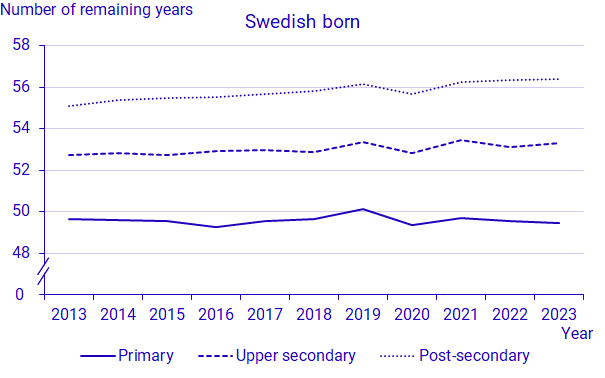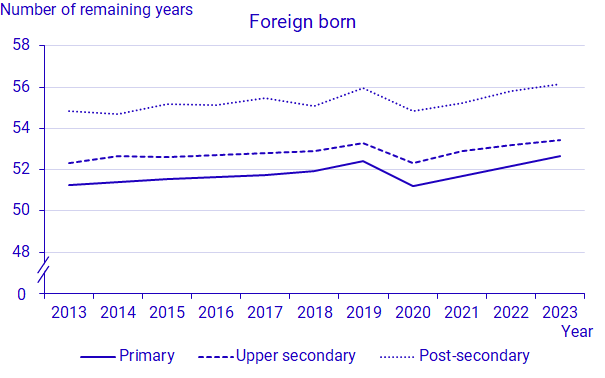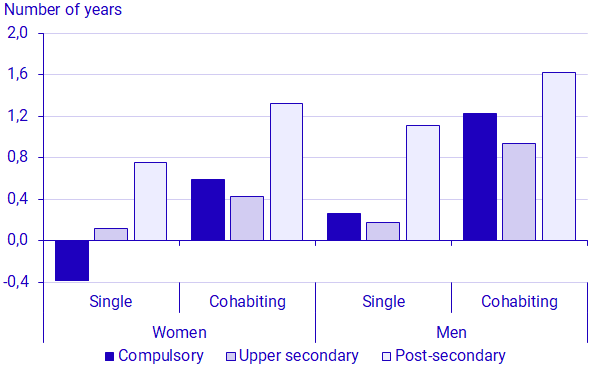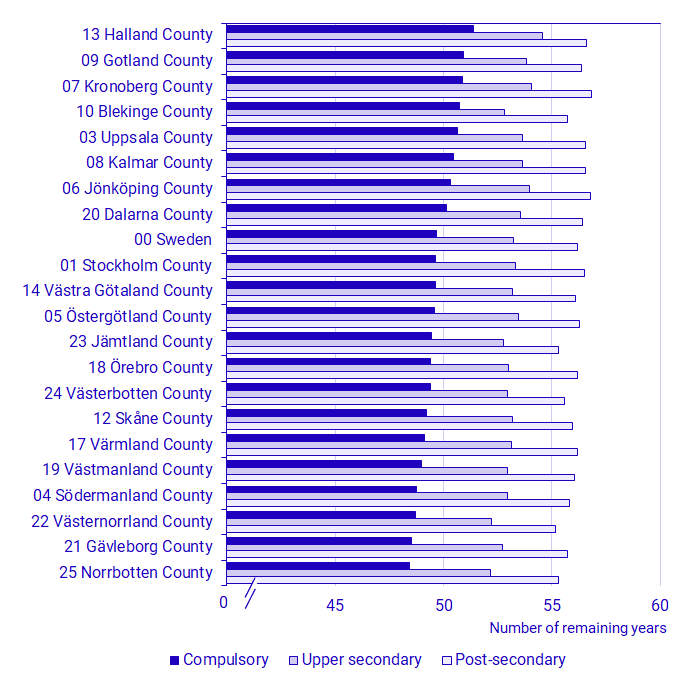Demographic Analysis (DEMOG) Remaining life expectancy by level of education
Faster increase in life expectancy among foreign born after 2020
Statistical news from Statistics Sweden 2024-05-30 8.00
The years around the COVID-19 pandemic saw some unusually large fluctuations in life expectancy, especially among the foreign born and individuals with lower education. Since then, life expectancy has returned to the same trend as before the pandemic for the Swedish born and increased faster than before the pandemic among the foreign born in all educational groups.
Life expectancy has been increasing over time in Sweden, both among the Swedish born and for those born abroad. However, the increase rate has been uneven, and varied between different sub-groups of the population. In 2020, life expectancy decreased significantly because of the COVID-19 pandemic, especially among the foreign born and those with only compulsory education. In total, life expectancy decreased with more than a year for the foreign born, as compared to half a year for the Swedish born. Among the foreign born with only compulsory education, life expectancy was lower in 2020 than it had been in 2013. Since 2020, the average increase in life expectancy among the foreign born has been about six months per year, which is more than double the speed of the increase among the Swedish born. This has meant a faster recuperation in life expectancy among the foreign born after 2020, despite the greater decrease from the pandemic. In 2023, life expectancy was higher among the foreign born in all educational groups compared to the year before the pandemic.
Increasing disparities in life expectancy among Swedish born
There are clear differences in life expectancy between groups of different educational level. People with post-secondary education have a few years higher life expectancy than those with upper secondary education, who in turn have higher life expectancy than those with only compulsory education. During the period 2013-2023, the differences between the groups with the highest- and lowest education has widened by almost two years among the Swedish born. While life expectancy has increased stably among those with post-secondary education, it has decreased slightly among those with only compulsory education. In 2023, the difference between these two groups was about 7 years. Among those with upper secondary education, life expectancy remained at roughly the same level during the first half of the period but since then, it has increased slightly. The difference between those with upper secondary- and post-secondary education has increased by about nine months between 2013 and 2023.


Life expectancy differences between educational groups are smaller among the foreign born than among the Swedish born. Throughout the period, the group with post-secondary education had an advantage of about 3,5 years compared to those with only compulsory education, and 2,5 years compared to those with upper-secondary education. Overall, life expectancy of the foreign born with upper secondary and post-secondary education has been relatively close to that of the Swedish born in the same educational groups, but among those with only compulsory education, life expectancy has been clearly higher for the foreign born and the difference has been increasing, from about 1,5 years in 2013 to three years in 2023.
Largest increase in life expectancy among cohabiting with higher education
Most of the deaths in Sweden occur in old age. Therefore, changes in mortality rates in old age tend to have a great impact on life expectancy, something clearly observed with the COVID-19 pandemic in recent years. When looking at remaining life expectancy at age 65, it has increased by one year between 2013 and 2023, from 21 to 22 years for women and from 18.5 to 19.7 years for men.
In the period 2013–2023, women and men has had about the same increase in life expectancy at age 65, but this is not the case for different educational groups. There are also significant differences between those living with a partner and those without. Remaining life expectancy at age 65 increases most for persons living with a partner and least for single persons. For single women with only compulsory education, life expectancy has not increased but decreased somewhat since 2013, and life expectancy of single women and men with upper secondary education has hardly changed at all. The greatest increase has occurred among those with post-secondary education.

Clear differences in all counties
Differences in the number of remaining years at age 30 between groups with different educational levels exist in all Swedish counties. This applies to both women and men but here it is shown only for both sexes combined.

Counties are sorted by the number of remaining years for the group with compulsory education.
There exists some variation between the counties in the number of remaining years at age 30. In the group with compulsory education, those who live in Halland County have the highest number of remaining years, 51,4 years, whereas those who live in Norrbotten County have the lowest number of remaining years, 48.4 years. In the group with upper secondary education, those who live in Halland County have the highest number of remaining years, 54.6 years whereas those who live in Norrbotten County have the lowest, 52,2 years. In the group with post-secondary education, those who live in Kronoberg County and Jönköping County have the highest number of remaining years, 56.8 years whereas those who live in Västernorrland County have the lowest, 55,2 years. In the period 2019—2022, the difference between these educational groups was smallest in Blekinge County, 5 years, and largest in Gävleborg County, 7.2 years.
Definitions and explanations
Average remaining life expectancy is normally referred to as “life expectancy”. This is an index that describes mortality in all ages for a year or a specific period. Mortality is shown in a life table and the average number of years remaining is calculated for all ages. Here, the number of remaining years is reported from the age of 30 and 65 years.
The statistics refer to persons aged 30 years and older who were registered in the population various years between 2011 and 2022. In the statistical database there is more information and complete life tables.
These statistics have been produced based on data in Statistics Sweden’s Population Register, Household Register, and Education Register.
Publication
These statistics are published as complete life tables from 30 years in the Statistical Database on the website of Statistics Sweden in the following tables:
Länk till SSD- för följande tabeller
- Life tables by level of education, region of birth (Swedish born and foreign born), sex and age. Year 2012–2023
- Life tables by level of education, type of household, sex and age. Year 2012–2023 (limited to the population born in Sweden)
- Life tables by level of education, county, sex and age. Five-year period 2012–2016 to 2019–2023 (limited to the population born in Sweden)
These statistics are also published in tables and figures with comments on remaining life expectancy at 30 years and at 65 years.
Feel free to use the facts from this statistical news but remember to state Source: Statistics Sweden.
